Conversion of Mechanical Energy to Electrical Energy Using Piezoelectric Materials for Bicycle Lane Lighting Systems
Abstract
:1. Introduction
- This study investigated the energy harvested from a piezoelectric energy harvesting system applied to the external environment and real-life activity, not only as a laboratory experiment.
- The proposed control algorithm offered an effective utilization and storage of energy for the bicycle lane or the area where visibility was inadequate.
- The proposed system can be further developed and implemented to support the concept of clean energy and inclusion in a smart city.
2. Design of the Energy Harvester
2.1. Simulation
2.2. Energy Harvesting from Piezoelectric Material
2.3. Power-Generation Bicycle Lane Using Piezoelectric Material Conceptual
3. Experiment and Result
4. Conclusions
Author Contributions
Funding
Institutional Review Board Statement
Informed Consent Statement
Data Availability Statement
Acknowledgments
Conflicts of Interest
References
- Reviewing world energy data for 70 years. In Statistical Review of World Energy 2021; BP p.l.c.: London, UK, 2022.
- U.S. Energy Information Administration; Office of Energy Analysis; U.S. Department of Energy. Annual Energy Outlook 2022; Bipartisan Policy Center: Washington, DC, USA, 2022.
- Paez-Montoro, A.; Garcia-Valderas, M.; Olias-Ruiz, E.; Lopez-Ongil, C. Solar Energy Harvesting to Improve Capabilities of Wearable Devices. Sensors 2022, 22, 3950. [Google Scholar] [CrossRef] [PubMed]
- Barreto, R.A. Fossil fuels, alternative energy and economic growth. Econ. Model. 2018, 75, 196–220. [Google Scholar] [CrossRef] [Green Version]
- Saidi, K.; Omri, A. The impact of renewable energy on carbon emissions and economic growth in 15 major renewable energy-consuming countries. Environ. Res. 2020, 186, 109567. [Google Scholar] [CrossRef]
- Coram, A.; Katzner, D.W. Reducing fossil-fuel emissions: Dynamic paths for alternative energy-producing technologies. Energy Econ. 2018, 70, 179–189. [Google Scholar] [CrossRef]
- Zafar, M.W.; Shahbaz, M.; Sinha, A.; Sengupta, T.; Qin, Q. How renewable energy consumption contribute to environmental quality? The role of education in OECD countries. J. Clean. Prod. 2020, 268, 122149. [Google Scholar] [CrossRef]
- Stančin, H.; Mikulčić, H.; Wang, X.; Duić, N. A review on alternative fuels in future energy system. Renew. Sustain. Energy Rev. 2020, 128, 109927. [Google Scholar] [CrossRef]
- Chiradeja, P.; Ngaopitakkul, A. Energy and Economic Analysis of Tropical Building Envelope Material in Compliance with Thailand’s Building Energy Code. Sustainability 2019, 11, 6872. [Google Scholar] [CrossRef] [Green Version]
- Choudhary, P.; Bhargava, L.; Singh, V.; Choudhary, M.; Suhag, A.K. A survey—Energy harvesting sources and techniques for internet of things devices. Mater. Today Proc. 2020, 30, 52–56. [Google Scholar] [CrossRef]
- Wang, S. Current status of PV in China and its future forecast. CSEE J. Power Energy Syst. 2020, 6, 72–82. [Google Scholar]
- Anderson, A.A.; Suryanarayanan, S. Review of energy management and planning of islanded microgrids. CSEE J. Power Energy Syst. 2020, 6, 329–343. [Google Scholar]
- Lai, Z.H.; Wang, J.L.; Zhang, C.L.; Zhang, G.Q.; Yurchenko, D. Harvest wind energy from a vibro-impact DEG embedded into a bluff body. Energy Convers. Manag. 2019, 199, 111993. [Google Scholar] [CrossRef]
- Sun, W.; Jo, S.; Seok, J. Development of the optimal bluff body for wind energy harvesting using the synergetic effect of coupled vortex induced vibration and galloping phenomena. Int. J. Mech. Sci. 2019, 156, 435–445. [Google Scholar] [CrossRef]
- Mohammadnia, A.; Rezania, A.; Ziapour, B.M.; Sedaghati, F.; Rosendahl, L. Hybrid energy harvesting system to maximize power generation from solar energy. Energy Convers. Manag. 2020, 205, 112352. [Google Scholar] [CrossRef]
- Leon, J.S.; Cioncolini, A.; Nabawy, M.R.A.; Revell, A.; Kennaugh, A. Simultaneous wind and solar energy harvesting with inverted flags. Appl. Energy 2019, 239, 846–858. [Google Scholar] [CrossRef] [Green Version]
- Chiradeja, P.; Pothisarn, C.; Jettanasen, C.; Yoomak, S.; Songsukthawan, P.; Bunjongjit, S.; Leelajindakrairerk, M.; Ngaopitakkul, A. Solar water heating in residential building. Int. J. Smart Grid Clean Energy 2019, 8, 422–429. [Google Scholar] [CrossRef]
- Sharma, H.; Haque, A.; Jaffery, Z.A. Maximization of wireless sensor network lifetime using solar energy harvesting for smart agriculture monitoring. Ad Hoc Netw. 2019, 94, 101966. [Google Scholar] [CrossRef]
- Yoomak, S.; Patcharoen, T.; Ngaopitakkul, A. Performance and Economic Evaluation of Solar Rooftop Systems in Different Regions of Thailand. Sustainability 2019, 11, 6647. [Google Scholar] [CrossRef] [Green Version]
- Kaza, N. Urban form and transportation energy consumption. Energy Policy 2020, 136, 111049. [Google Scholar] [CrossRef]
- Xu, J.H.; Guo, J.F.; Peng, B.; Nie, H.; Kemp, R. Energy growth sources and future energy-saving potentials in passenger transportation sector in China. Energy 2020, 206, 118142. [Google Scholar] [CrossRef]
- Pedro, L.; Verdezoto, C.; Vidoza, J.A.; Gallo, W.L.R. Analysis and projection of energy consumption in Ecuador: Energy efficiency policies in the transportation sector. Energy Policy 2019, 134, 110948. [Google Scholar]
- Yoomak, S.; Ngaopitakkul, A. Investigation and Feasibility Evaluation of Using Nanogrid Technology Integrated into Road Lighting System. IEEE Access 2020, 8, 56739–56754. [Google Scholar] [CrossRef]
- Sonmez, M.; Akgüngör, A.P.; Bektaş, S. Estimating transportation energy demand in Turkey using the artificial bee colony algorithm. Energy 2017, 122, 301–310. [Google Scholar] [CrossRef]
- Lampinen, A. Dealing with victor’s history in renewable energy education for transportation applications. Solar Energy 2018, 173, 272–276. [Google Scholar] [CrossRef]
- Olivares, A.G.; Solé, J.; Osychenko, O. Transportation in a 100% renewable energy system. Energy Convers. Manag. 2018, 158, 266–285. [Google Scholar] [CrossRef]
- Hung, N.B.; Lim, O. A review of history, development, design and research of electric bicycles. Appl. Energy 2019, 260, 114323. [Google Scholar] [CrossRef]
- Shui, C.S.; Szeto, W.Y. A review of bicycle-sharing service planning problems. Transp. Res. Part C Emerg. Technol. 2020, 117, 102648. [Google Scholar] [CrossRef]
- Yang, Y.; Pian, Y.; Liu, Q. Design of energy harvester using rotating motion rectifier and its application on bicycle. Energy 2019, 179, 222–231. [Google Scholar] [CrossRef]
- Guanetti, J.; Formentin, S.; Corno, M.; Savaresi, S.M. Optimal energy management in series hybrid electric bicycles. Automatica 2017, 81, 96–106. [Google Scholar] [CrossRef]
- Bucher, D.; Buffat, R.; Froemelt, A.; Raubal, M. Energy and greenhouse gas emission reduction potentials resulting from different commuter electric bicycle adoption scenarios in Switzerland. Renew. Sustain. Energy Rev. 2019, 114, 109298. [Google Scholar] [CrossRef]
- Sarker, M.R.; Julai, S.; Sabri, M.F.M.; Said, S.M.; Islam, M.M.; Tahir, M. Review of piezoelectric energy harvesting system and application of optimization techniques to enhance the performance of the harvesting system. Sens. Actuators A Phys. 2019, 300, 111634. [Google Scholar] [CrossRef]
- Ali, W.R.; Prasad, M. Piezoelectric MEMS based acoustic sensors: A review. Sens. Actuators A Phys. 2020, 301, 111756. [Google Scholar] [CrossRef]
- Li, X.; Upadrashta, D.; Yu, K.; Yang, Y. Analytical modeling and validation of multi-mode piezoelectric energy harvester. Mech. Syst. Signal Processing 2019, 124, 613–631. [Google Scholar] [CrossRef]
- Khalili, M.; Biten, A.B.; Vishwakarma, G.; Ahmed, S.; Papagiannakis, A.T. Electro-mechanical characterization of a piezoelectric energy harvester. Appl. Energy 2019, 253, 113585. [Google Scholar] [CrossRef]
- Pal, A.; Sasmal, A.; Manoj, B.; Prasada Rao, D.S.D.; Haldar, A.K.; Shrabanee, S. Enhancement in energy storage and piezoelectric performance of three phase (PZT/MWCNT/PVDF) composite. Mater. Chem. Phys. 2020, 244, 122639. [Google Scholar] [CrossRef]
- Zou, H.X.; Zhang, W.; Li, W.B.; Wei, K.X.; Gao, Q.H.; Peng, Z.K.; Meng, G. Design and experimental investigation of a magnetically coupled vibration energy harvester using two inverted piezoelectric cantilever beams for rotational motion. Energy Convers. Manag. 2017, 148, 1391–1398. [Google Scholar] [CrossRef]
- Qian, F.; Xu, T.B.; Zuo, L. Design, optimization, modeling and testing of a piezoelectric footwear energy harvester. Energy Convers. Manag. 2018, 171, 1352–1364. [Google Scholar] [CrossRef]
- Chen, Z.; Xia, Y.; He, J.; Xiong, Y.; Wang, G. Elastic-electro-mechanical modeling and analysis of piezoelectric metamaterial plate with a self-powered synchronized charge extraction circuit for vibration energy harvesting. Mech. Syst. Signal Processing 2020, 143, 106824. [Google Scholar] [CrossRef]
- Iqbal, M.; Khan, F.U. Hybrid vibration and wind energy harvesting using combined piezoelectric and electromagnetic conversion for bridge health monitoring applications. Energy Convers. Manag. 2018, 172, 611–618. [Google Scholar] [CrossRef]
- Izadgoshasb, I.; Lim, Y.Y.; Lake, N.; Tang, L.; Padilla, R.V.; Kashiwao, T. Optimizing orientation of piezoelectric cantilever beam for harvesting energy from human walking. Energy Convers. Manag. 2018, 161, 66–73. [Google Scholar] [CrossRef]
- Wu, Y.; Qiu, J.; Zhou, S.; Ji, H.; Chen, Y.; Li, S. A piezoelectric spring pendulum oscillator used for multi-directional and ultra-low frequency vibration energy harvesting. Appl. Energy 2018, 231, 600–614. [Google Scholar] [CrossRef]
- Wang, J.; Tang, L.; Zhao, L.; Zhang, Z. Efficiency investigation on energy harvesting from airflows in HVAC system based on galloping of isosceles triangle sectioned bluff bodies. Energy 2019, 172, 1066–1078. [Google Scholar] [CrossRef]
- Chen, J.; Qiu, Q.; Han, Y.; Lau, D. Piezoelectric materials for sustainable building structures: Fundamentals and applications. Renew. Sustain. Energy Rev. 2019, 101, 14–25. [Google Scholar] [CrossRef]
- Hu, G.; Tse, K.T.; Wei, M.; Naseer, R.; Abdelkefi, A.; Kwok, K.C.S. Experimental investigation on the efficiency of circular cylinder-based wind energy harvester with different rod-shaped attachments. Appl. Energy 2018, 226, 682–689. [Google Scholar] [CrossRef]
- Sun, W.; Zhao, D.; Tan, T.; Yan, Z.; Guo, P.; Luo, X. Low velocity water flow energy harvesting using vortex induced vibration and galloping. Appl. Energy 2019, 251, 113392. [Google Scholar] [CrossRef]
- Shan, X.; Li, H.; Yang, Y.; Feng, J.; Wang, Y.; Xie, T. Enhancing the performance of an underwater piezoelectric energy harvester based on flow-induced vibration. Energy 2019, 172, 134–140. [Google Scholar] [CrossRef]
- Toyabur, R.M.; Salauddin, M.; Cho, H.; Park, J.Y. A multimodal hybrid energy harvester based on piezoelectric-electromagnetic mechanisms for low-frequency ambient vibrations. Energy Convers. Manag. 2018, 168, 454–466. [Google Scholar] [CrossRef]
- Naseer, R.; Dai, H.L.; Abdelkefi, A.; Wang, L. Piezomagnetoelastic energy harvesting from vortex-induced vibrations using monostable characteristics. Appl. Energy 2017, 203, 142–153. [Google Scholar] [CrossRef]
- Nowak, R.; Pietrzakowski, M.; Rumianek, P. Influence of design parameters on bending piezoelectric harvester effectiveness: Static approach. Mech. Syst. Signal Processing 2020, 143, 106833. [Google Scholar] [CrossRef]
- Jettanasen, C.; Songsukthawan, P.; Ngaopitakkul, A. Development of micro-mobility based on piezoelectric energy harvesting for smart city applications. Sustainability 2020, 12, 2020. [Google Scholar]
- Ghodsi, M.; Ziaiefar, H.; Mohammadzaheri, M.; Al-Yahmedi, A. Modeling and characterization of permendur cantilever beam for energy harvesting. Energy 2019, 176, 561–569. [Google Scholar] [CrossRef]
- Mohammadzaheri, M.; AlQallaf, A. Nanopositioning systems with piezoelectric actuators, current state and future perspective. Sci. Adv. Mater. 2017, 9, 1071–1080. [Google Scholar] [CrossRef]
- Cheng, C.H.; Wu, M.F.; Guo, S.H.; Chen, K.S. Realization and performance assessment of a force-sensing based smart floor panel for indoor localization applications. Sens. Actuators A Phys. 2019, 285, 468–481. [Google Scholar] [CrossRef]
- Wang, C.; Zhao, J.; Li, Q.; Li, Y. Optimization design and experimental investigation of piezoelectric energy harvesting devices for pavement. Appl. Energy 2018, 229, 18–30. [Google Scholar] [CrossRef]
- Wang, C.; Song, Z.; Gao, Z.; Yu, G.; Wang, S. Preparation and performance research of stacked piezoelectric energy-harvesting units for pavements. Energy Build. 2019, 183, 581–591. [Google Scholar] [CrossRef]
- Evans, M.; Tang, L.; Tao, K.; Aw, K. Design and optimisation of an underfloor energy harvesting system. Sens. Actuators A Phys. 2019, 285, 613–622. [Google Scholar] [CrossRef]
- Elhalwagy, A.M.; Ghoneem, M.Y.M.; Elhadidi, M. Feasibility Study for Using Piezoelectric Energy Harvesting Floor in Buildings’ Interior Spaces. Energy Procedia 2017, 115, 114–126. [Google Scholar] [CrossRef]
- Jasim, A.; Yesner, G.; Wang, H.; Safari, A.; Maher, A.; Basily, B. Laboratory testing and numerical simulation of piezoelectric energy harvester for roadway applications. Appl. Energy 2018, 224, 438–447. [Google Scholar] [CrossRef]
- Wang, C.; Wang, S.; Li, Q.J.; Wang, X.; Gao, Z.; Zhang, L. Fabrication and performance of a power generation device based on stacked piezoelectric energy-harvesting units for pavements. Energy Convers. Manag. 2018, 163, 196–207. [Google Scholar] [CrossRef]
- Tahami, S.A.; Gholikhani, M.; Nasouri, R.; Dessouky, S.; Papagiannakis, A.T. Developing a new thermoelectric approach for energy harvesting from asphalt pavements. Appl. Energy 2019, 238, 786–795. [Google Scholar] [CrossRef]
- Song, G.J.; Cho, J.Y.; Kim, K.B.; Ahn, J.H.; Song, Y.; Hwang, W.; Hong, S.D.; Sung, T.H. Development of a pavement block piezoelectric energy harvester for self-powered walkway applications. Appl. Energy 2019, 256, 113916. [Google Scholar] [CrossRef]
- Kim, K.B.; Cho, J.Y.; Jabbar, H.; Ahn, J.H.; Hong, S.D.; Woo, S.B.; Sung, T.H. Optimized composite piezoelectric energy harvesting floor tile for smart home energy management. Energy Convers. Manag. 2018, 171, 31–37. [Google Scholar] [CrossRef]
- Chegenizadeh, A.; Aung, M.-O.; Nikraz, H. Ethylene Propylene Diene Monomer (EPDM) Effect on Asphalt Performance. Buildings 2021, 11, 315. [Google Scholar] [CrossRef]
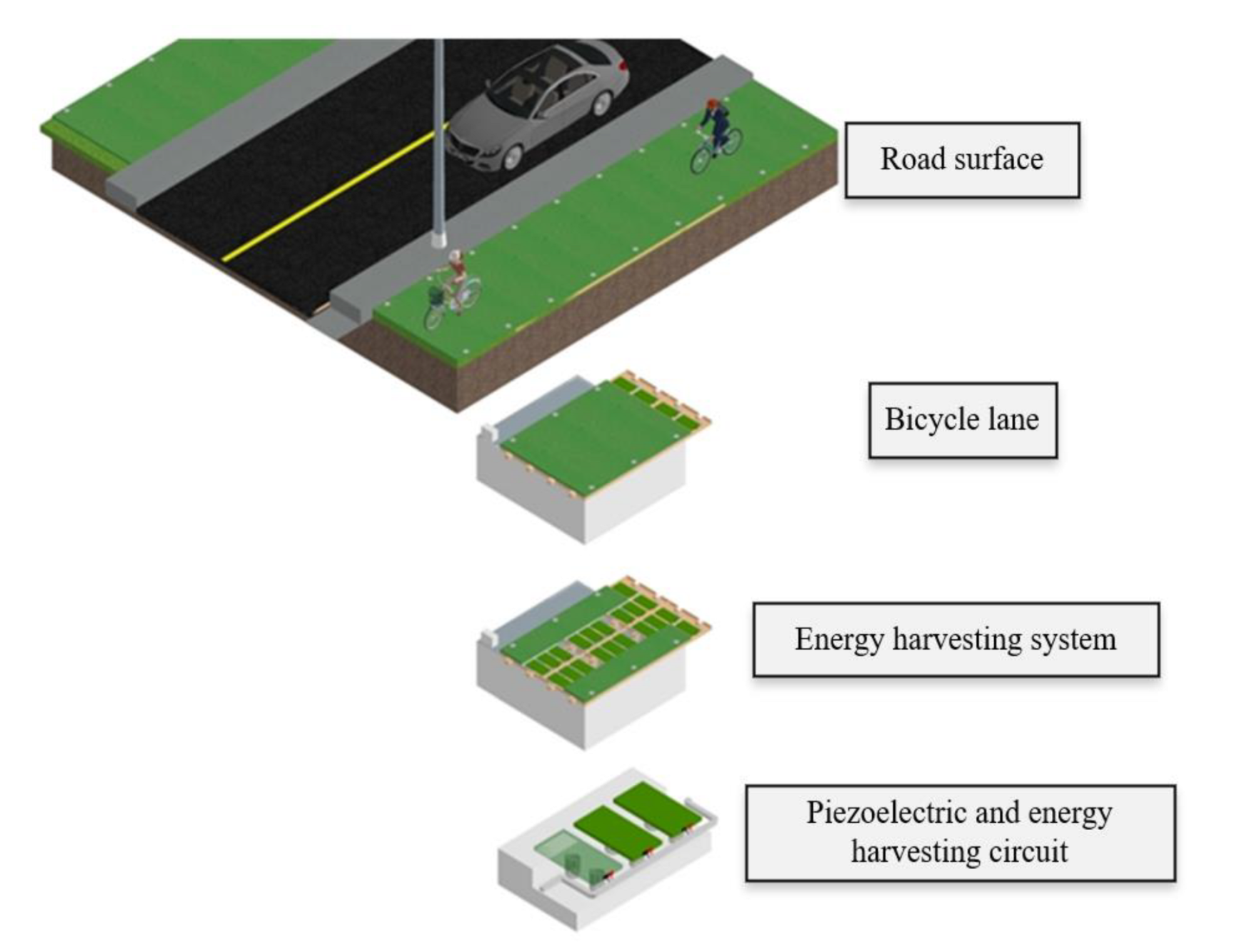
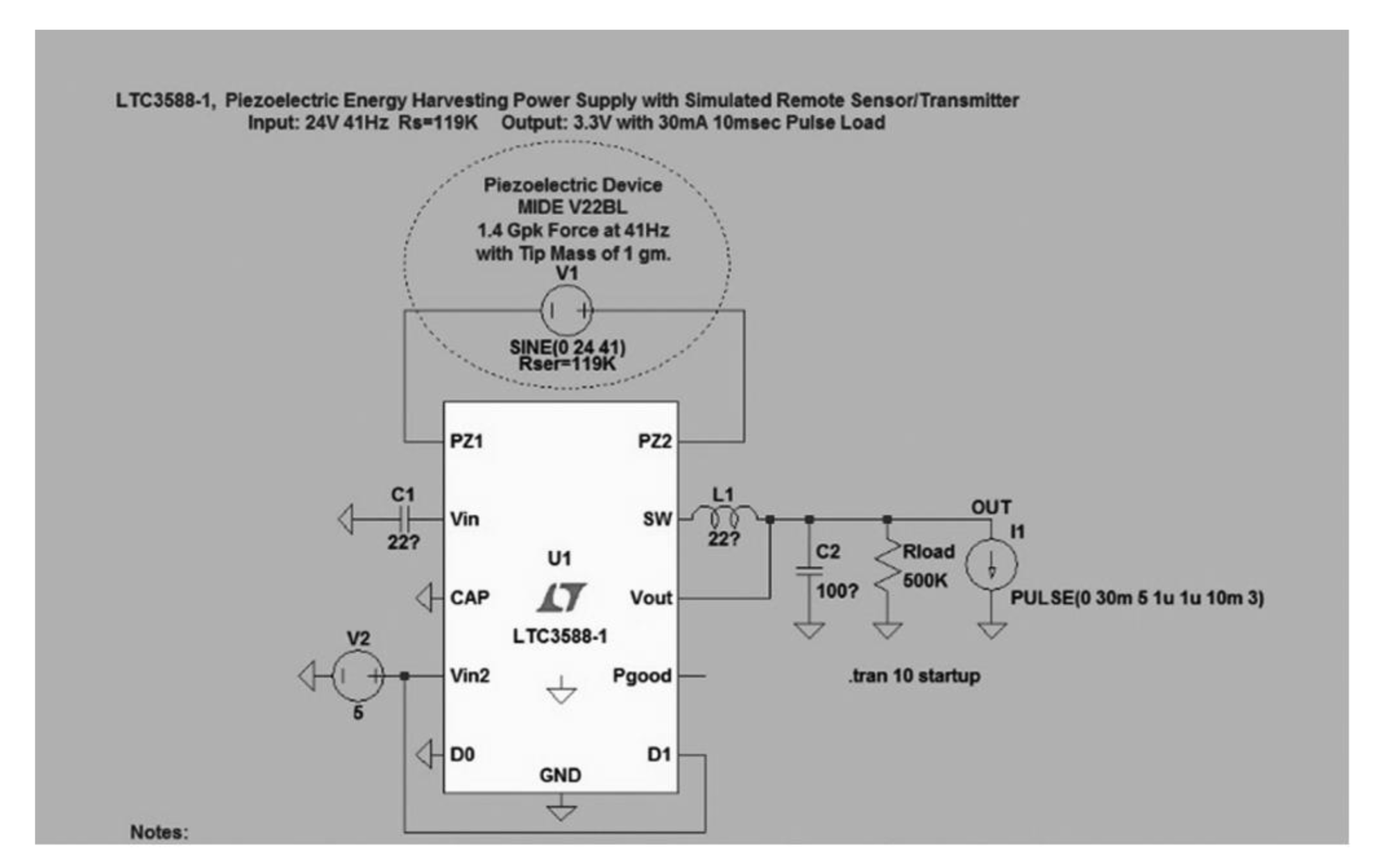


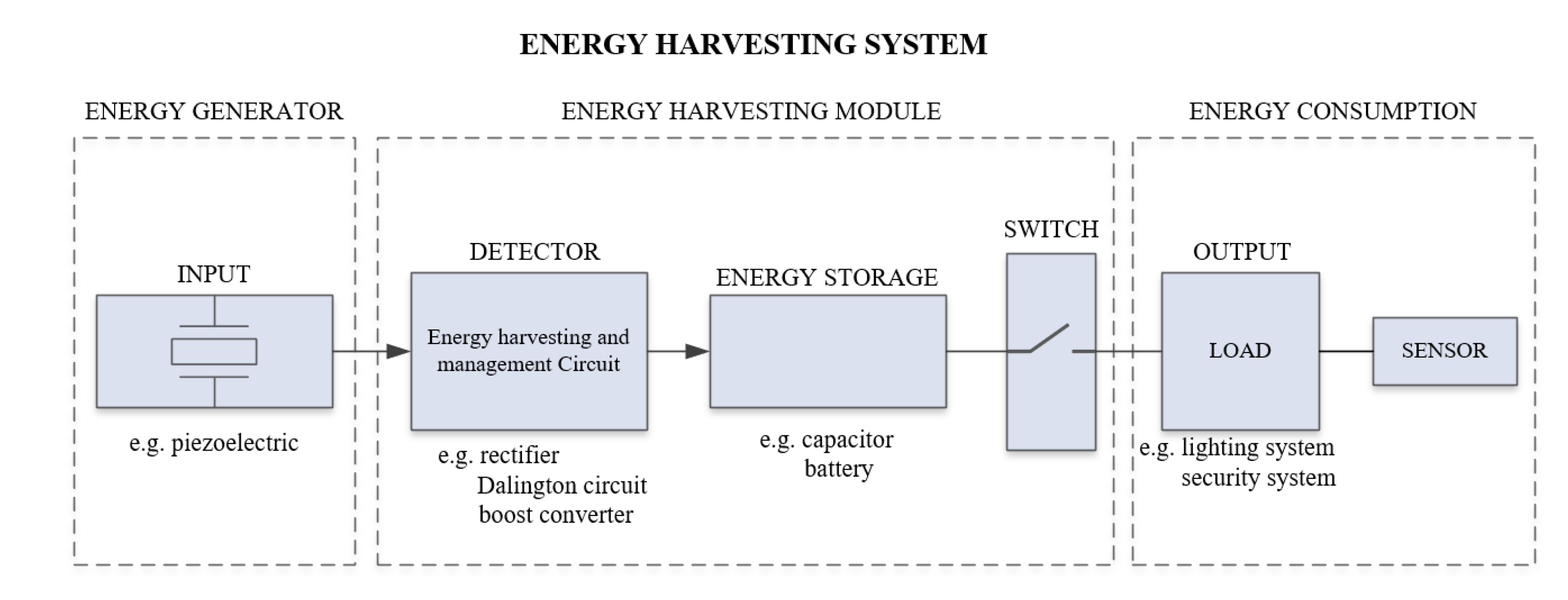
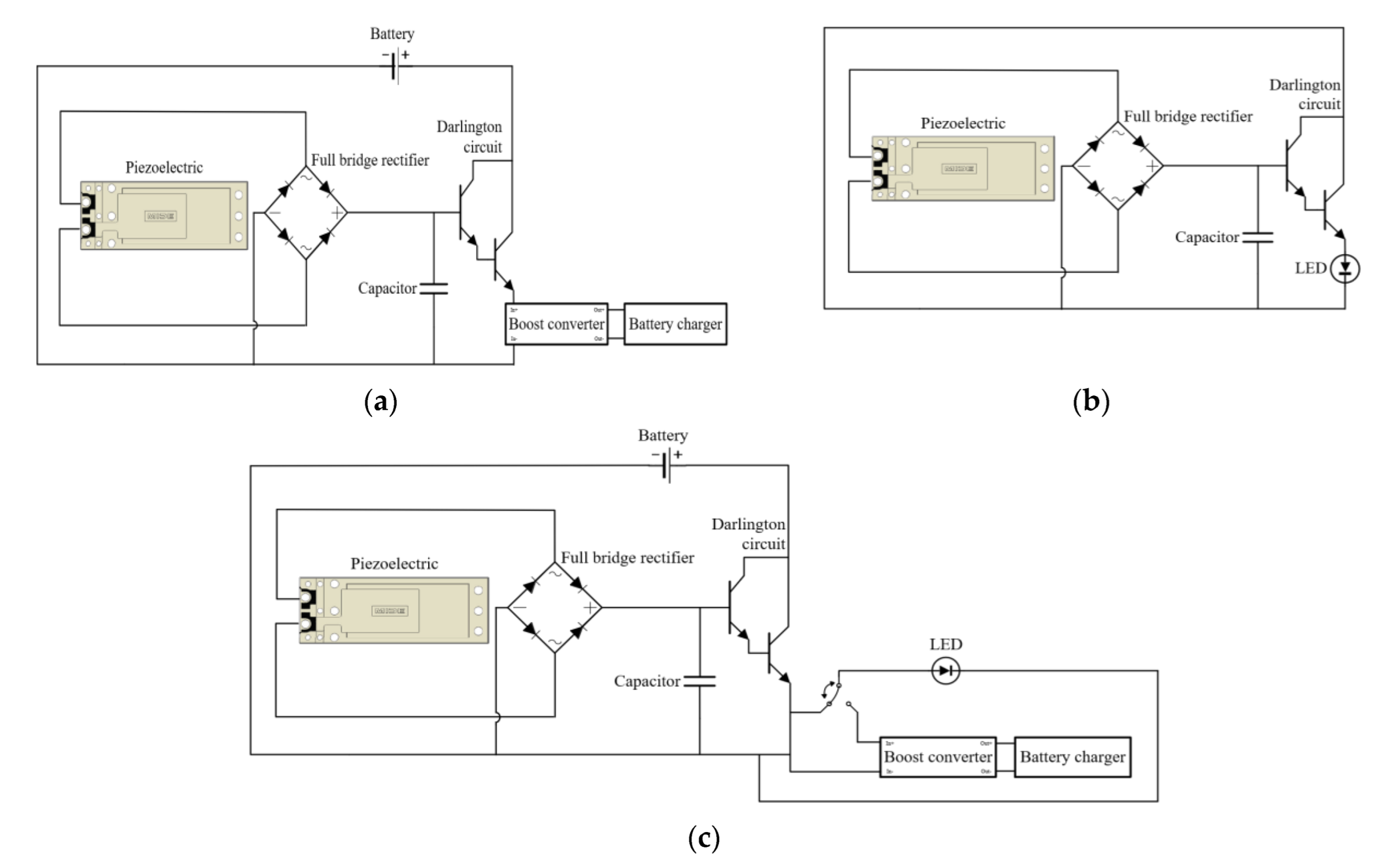

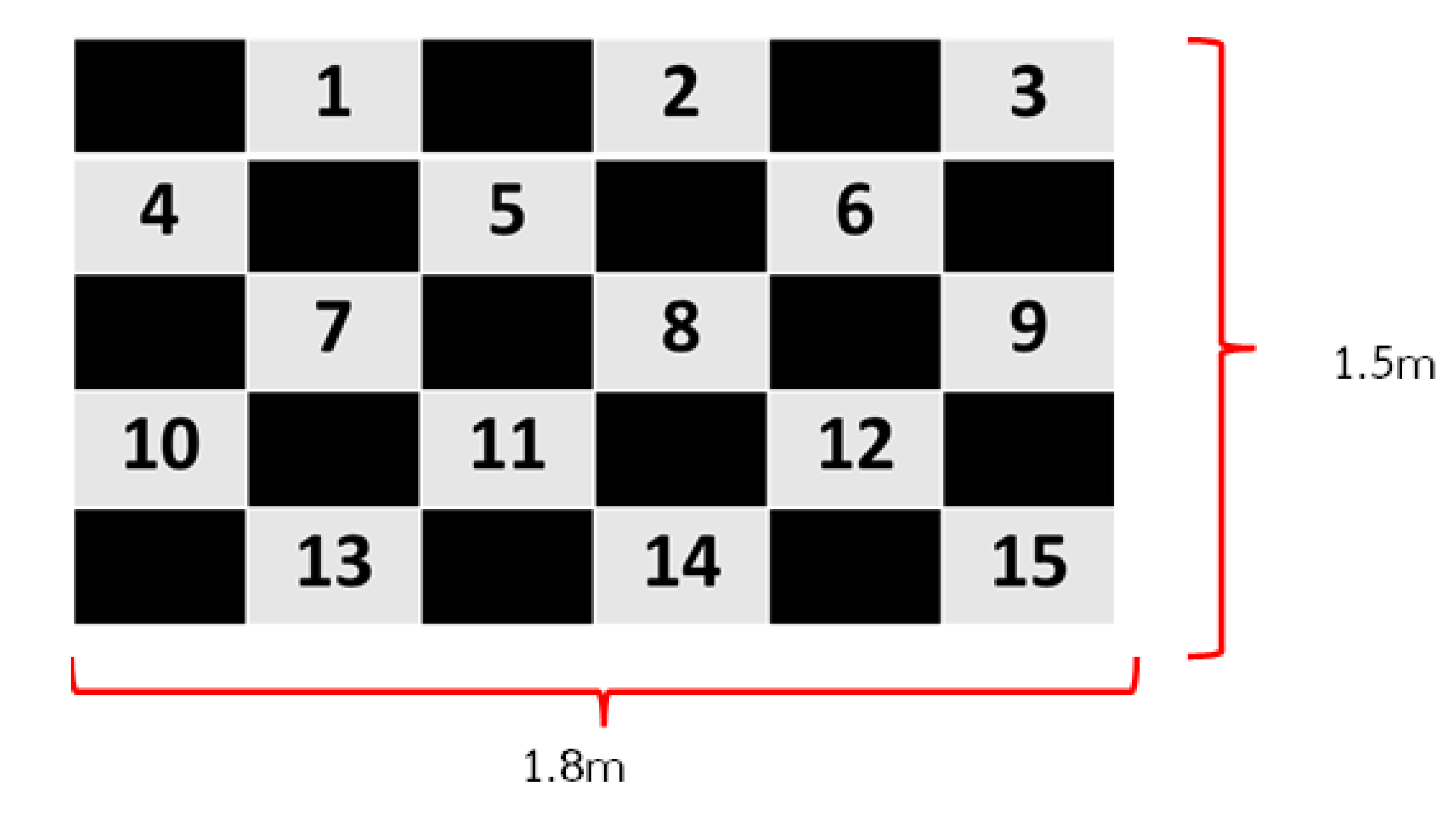

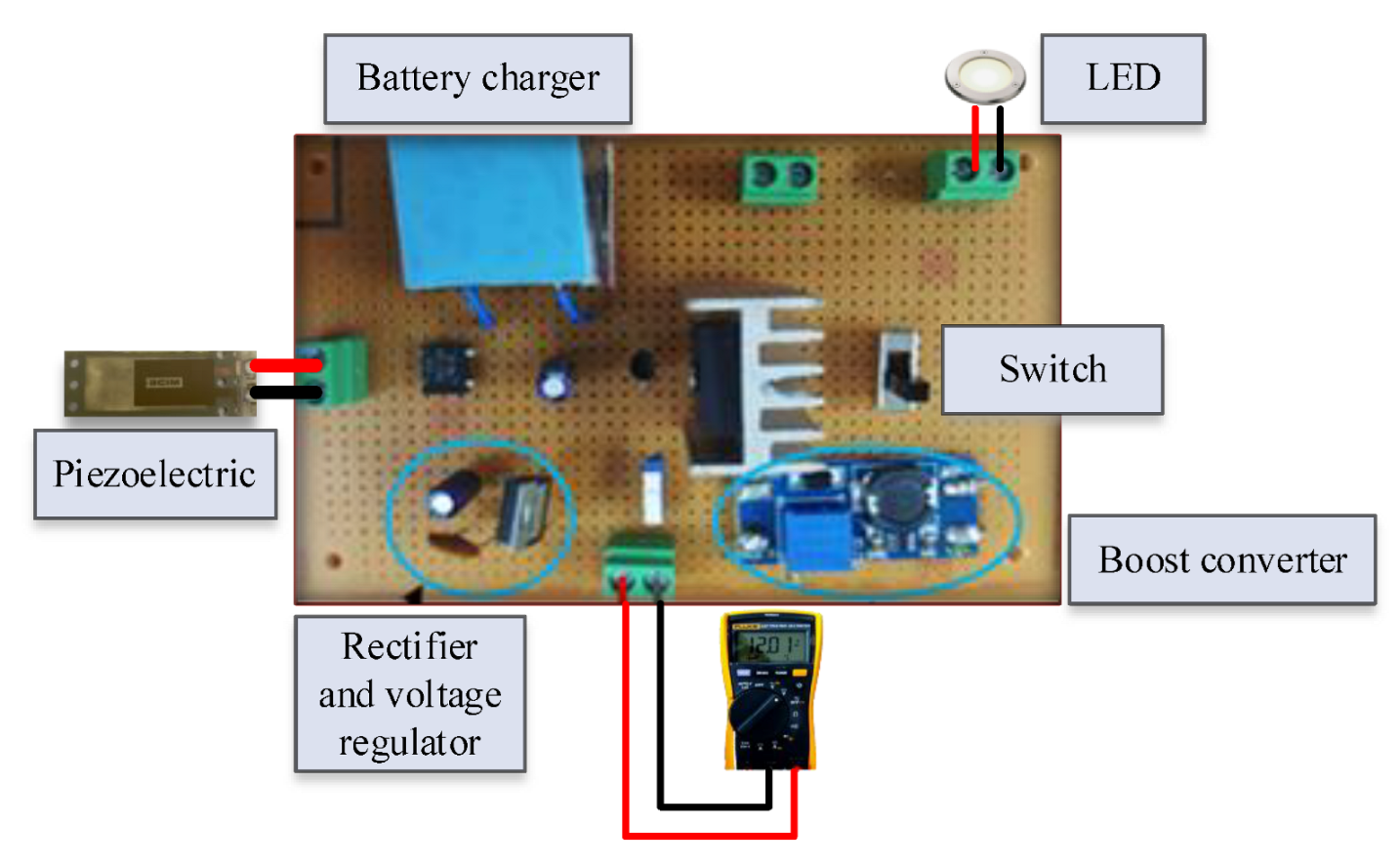
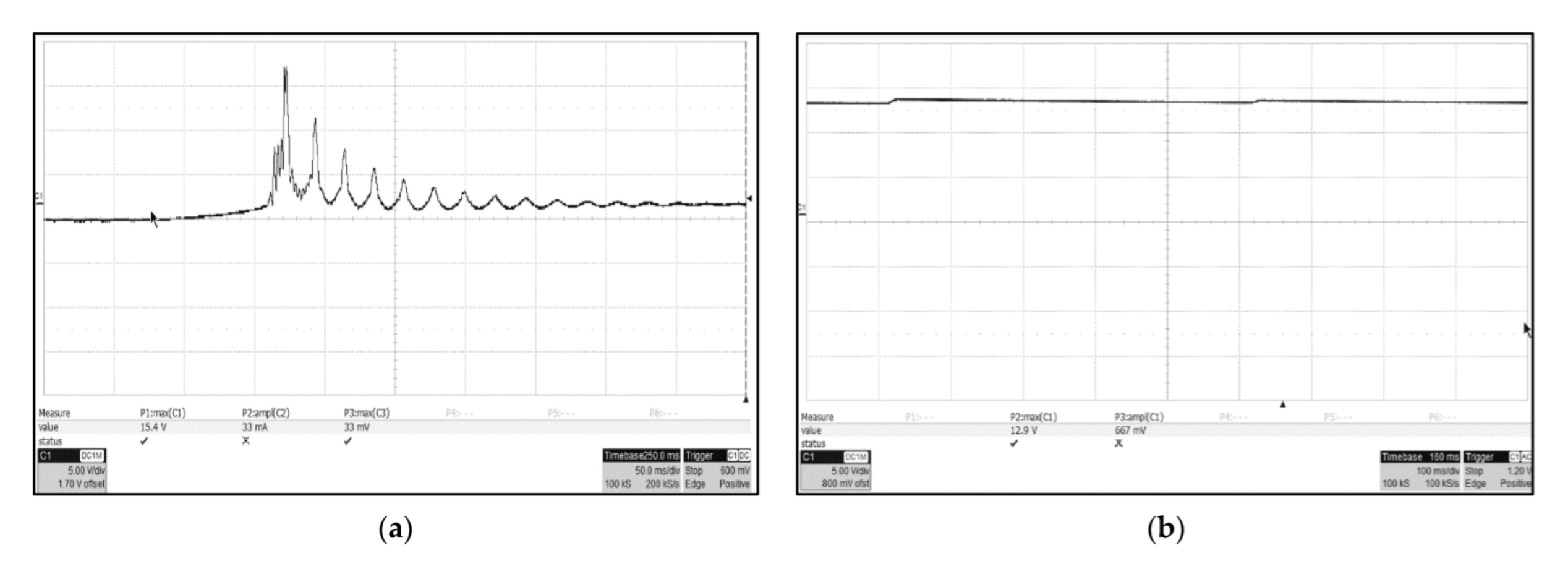
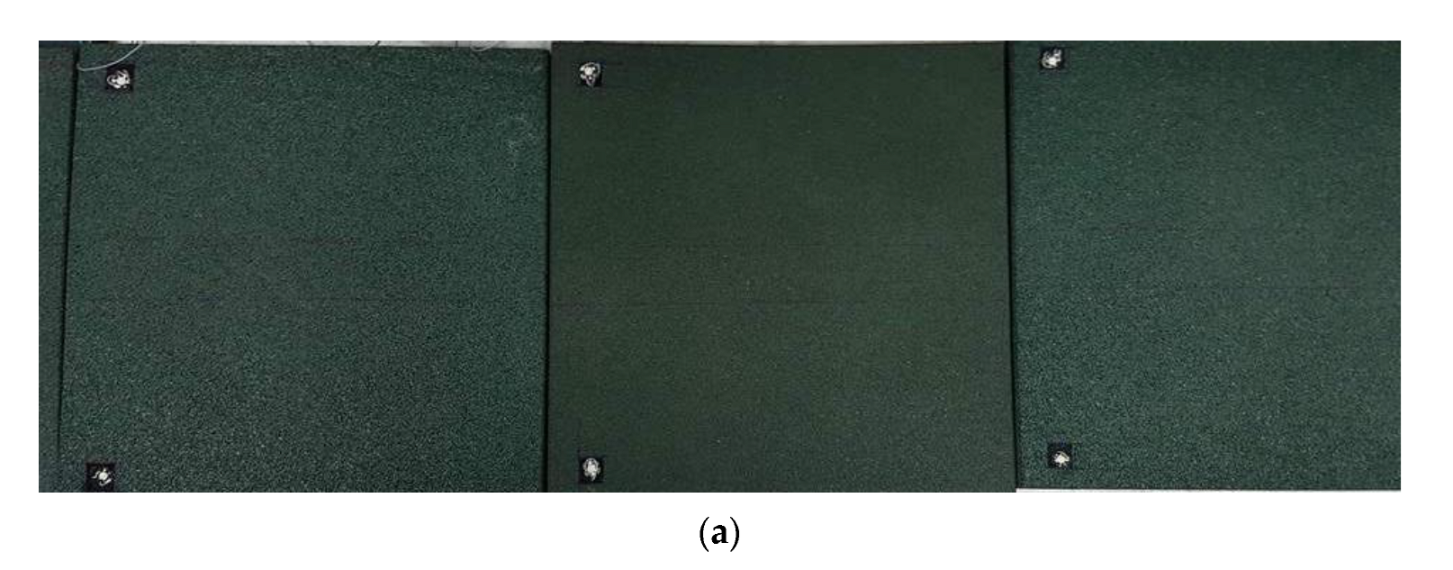
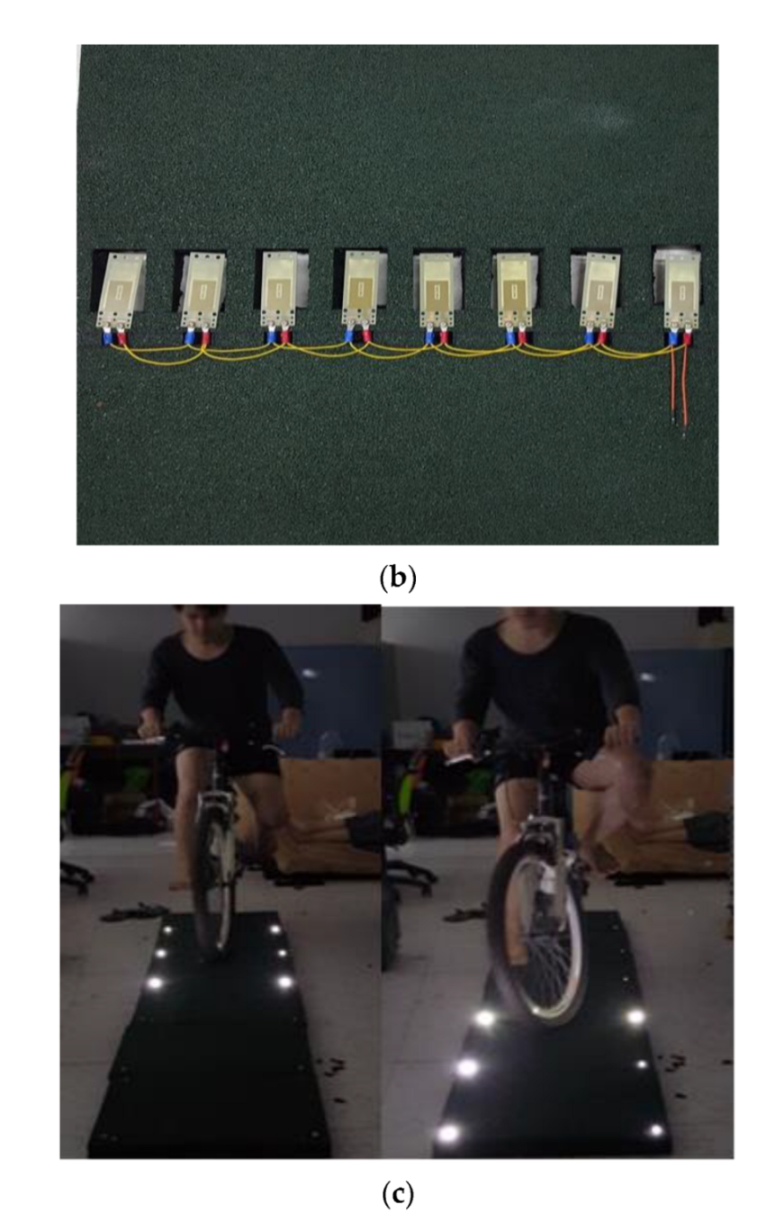
| Test Scenarios and Configurations | Method | Reference |
|---|---|---|
| Introduced piezoelectric energy harvesting from traffic-induced pavement vibrations | Comparative analysis of various disclosed piezoelectric harvesting device technology and material configurations was examined using different cover plates. | [55] |
| Prepared stacked piezoelectric energy harvesting units for pavements and evaluated their performance | Evaluated their application performance in terms of electrode structure (resistivity and cost) and technical characteristics (output power and durability) | [56] |
| Modeled and optimized an underfloor piezoelectric stacked energy harvester utilizing a force amplification frame | Optimized the device to suit a range of typical inputs, including walking, jogging, and multiple other pedestrian load conditions | [57] |
| Maximized the benefits from piezoelectric energy harvesting floor in buildings’ interior spaces, despite their being low pedestrian-traffic spaces | Used various piezoelectric technology types and spreading to correlate between needed power and pedestrian density | [58] |
| Evaluated energy output and mechanical failure of piezoelectric energy harvester for roadway applications | Experimental testing and numerical modeling (finite element simulation) of energy harvester | [59] |
| Designed and assessed stacked piezoelectric energy harvesting power-generation devices for pavements | Mechanical testing and simulation (MTS) determined durability and power generation performance. | [60] |
| Number of Mechanically Applied Preliminary Test Kit (Sets) | Charging Time(s) |
|---|---|
| 1 | 3.50 |
| 2 | 1.75 |
| 3 | 0.88 |
| 4 | 0.44 |
| 5 | 0.22 |
| 6 | 0.11 |
| 7 | 0.05 |
| 8 | 0.03 |
| 9 | 0.02 |
| 10 | 0.01 |
| Property | Value | Unit |
|---|---|---|
| Overall dimensions (length × width × thickness) of piezoelectric modules | 71.0 × 25.4 × 0.76 | mm |
| Density | 7.8 | g/cm³ |
| Dielectric constant (1 KHz) | 3800 | - |
| Piezoelectric voltage coefficient g33 | 19.0 | V∙m/N × 10−3 |
| Piezoelectric voltage coefficient g31 | −9.5 | V∙m/N × 10−3 |
| Piezoelectric charge(displacement) coefficient d33 | 650 | m/V × 10−12 |
| Piezoelectric charge(displacement) coefficient d31 | −320 | m/V × 10−12 |
| Capacitance | 190 | nF |
| Trial Number | Voltage When the Spring Was Not Installed (V) | Voltage When the Spring Was Installed (V) |
|---|---|---|
| 1 | 5.12 | 15.30 |
| 2 | 4.87 | 16.71 |
| 3 | 4.87 | 15.66 |
| 4 | 5.57 | 13.67 |
| 5 | 6.14 | 15.98 |
| 6 | 5.14 | 15.14 |
| 7 | 4.98 | 14.65 |
| 8 | 5.88 | 14.47 |
| 9 | 5.00 | 16.11 |
| 10 | 4.31 | 17.01 |
| Weight (kg) | Voltage (V) | Current (A) | Power (W) |
|---|---|---|---|
| 55 | 2.87 | 0.328 | 0.9414 |
| 75 | 3.17 | 0.363 | 1.1507 |
| 90 | 3.33 | 0.403 | 1.3420 |
| Speed (km/h) | Voltage (V) | Current (A) | Power (W) |
|---|---|---|---|
| 5 | 3.20 | 0.352 | 1.1264 |
| 10 | 3.12 | 0.309 | 1.0976 |
| 20 | 3.20 | 0.343 | 0.9641 |
Publisher’s Note: MDPI stays neutral with regard to jurisdictional claims in published maps and institutional affiliations. |
© 2022 by the authors. Licensee MDPI, Basel, Switzerland. This article is an open access article distributed under the terms and conditions of the Creative Commons Attribution (CC BY) license (https://creativecommons.org/licenses/by/4.0/).
Share and Cite
Jettanasen, C.; Songsukthawan, P.; Ngaopitakkul, A. Conversion of Mechanical Energy to Electrical Energy Using Piezoelectric Materials for Bicycle Lane Lighting Systems. Appl. Sci. 2022, 12, 7237. https://doi.org/10.3390/app12147237
Jettanasen C, Songsukthawan P, Ngaopitakkul A. Conversion of Mechanical Energy to Electrical Energy Using Piezoelectric Materials for Bicycle Lane Lighting Systems. Applied Sciences. 2022; 12(14):7237. https://doi.org/10.3390/app12147237
Chicago/Turabian StyleJettanasen, Chaiyan, Panapong Songsukthawan, and Atthapol Ngaopitakkul. 2022. "Conversion of Mechanical Energy to Electrical Energy Using Piezoelectric Materials for Bicycle Lane Lighting Systems" Applied Sciences 12, no. 14: 7237. https://doi.org/10.3390/app12147237
APA StyleJettanasen, C., Songsukthawan, P., & Ngaopitakkul, A. (2022). Conversion of Mechanical Energy to Electrical Energy Using Piezoelectric Materials for Bicycle Lane Lighting Systems. Applied Sciences, 12(14), 7237. https://doi.org/10.3390/app12147237





